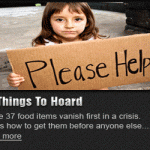How Will Small Towns and Cities Cope with Widespread Disaster? Disaster Food Preparation is Key
 Have you ever gone hungry for reasons other than simply skipping a meal, or perhaps two? Although such experiences do happen in the United States, they are certainly not the normal household experience. Hunger is a very motivating source and without proper planning and organization, a lack of food multiplied among groups of people can lead to a very dangerous situation.
Have you ever gone hungry for reasons other than simply skipping a meal, or perhaps two? Although such experiences do happen in the United States, they are certainly not the normal household experience. Hunger is a very motivating source and without proper planning and organization, a lack of food multiplied among groups of people can lead to a very dangerous situation.Local organizations can plan ahead in order to provide for the sustenance needs of various sized groups.The key word in supplying for the needs of a segment of the population is sustenance. It is invariably impossible to provide luxury items such as fresh beef and dairy products in the immediate aftermath of some catastrophic event. Under such a circumstance there may be people that demand the very things we as a nation have taken for granted for so long, but the largest segment will simply take whatever is offered to them (or that they can find).
Perhaps the greatest advice that can be given by any group or agency to their nearby population would be that everyone should make attempts beforehand to store up some measure of food and clean drinking water. That said, many people will not store their own food for a variety of reasons. The more individuals and families that do prepare in advance will lessen the initial burden on any attempt at mass food supply. Even so, demand will rise the longer such a disaster occurs, thus so any organization planning to be a clearinghouse for large quantities of food should consider the long term ramifications of their plan.
Types of food to distribute will follow, but the most crucial point of any distribution plan is the manner in which any and all supplies will be stored. Every effort should be made to ensure the following characteristics are met by a storage facility:
As crucial as a food warehousing program is, these simple steps are but the very basics of protecting a food supply. Volumes can and have been written on the topic of storing large quantities of food. It would be highly recommended that individuals or organizations desiring to develop such an important program contact local officials or perhaps take a certified course in food warehousing. Performing such a task is not as simple as four walls, a roof and a stockpile of food.
Freeze-dried food provides greatest ease of storage and longest shelf-life
On the subject of types of food to store, the type that provides the greatest ease of storage and shelf-life is freeze-dried food. There are numerous companies that specialize in producing freeze-dried goods. Those with the longest shelf-life and most impervious to infestation by insects and animals are prepared in #10 cans. These cans, normally associated with coffee, are sealed at the factory and many of them can be stored for up to 25 years. Dry rice is another food staple that is utilized throughout the world in troubled areas to supply sustenance to deprived populations. If your plan includes the storage of rice, take into consideration the factors listed above to protect your supply.Beyond the essentials of storing an emergency supply of food, some organizations may consider various additional resources that may be needed if a catastrophe lasts longer than the planned supply. Hunting wild game and growing fresh crops are possible options, but must be addressed beforehand.
Growing food crops is not an easy task and should not be taken lightly. Hunting for game involves stockpiles of arms and ammunition that could be devastating if they fell into the wrong hands. Another possible option in an extended disaster would be to send out forage parties to locate surplus food supplies in closed supermarkets and other food-related business. This option comes with an inherent risk of additional forage parties seeking the same supplies.
When disaster strikes … put togeter a willing and loyal worforce
Remember too that no plan is successful without the dedication of a willing and loyal workforce. Able bodied people will be needed to move supplies, provide security and to keep watch over the crowds. Your workforce should be built with individuals that can not only work as a team, but will be reliable to provide safe and sanitary service to the people that you are helping.
If there is any question as to the loyalty or mental/emotional stability of anyone in the workforce, the midst of a chaotic situation is not the time to be making changes to the roster. Although such tasks may be inevitable among one or two members of the team, a cohesive hierarchy and well-choreographed plan will minimize personnel issues. Leaders must be able to handle the pressures of even unforeseen tasks. The loyalty of security workers should be unquestionable. Strength and endurance by those handling the goods is essential.
As a disaster runs its course, depending upon the length of time, it may be necessary to fold new members into the team. If such a scenario develops, the same rules apply, but an extra measure of scrutiny would be in order during times of special duress.
Maintaining order
If your goal is to provide a safe and stable food supply, handling a mutiny or revolt may lead to ultimate disaster. Take time, while you can, to investigate every possible solution, scenario and outcome to ensure that the people who are looking to you for support can receive sustenance in a safe and predictable manner.





